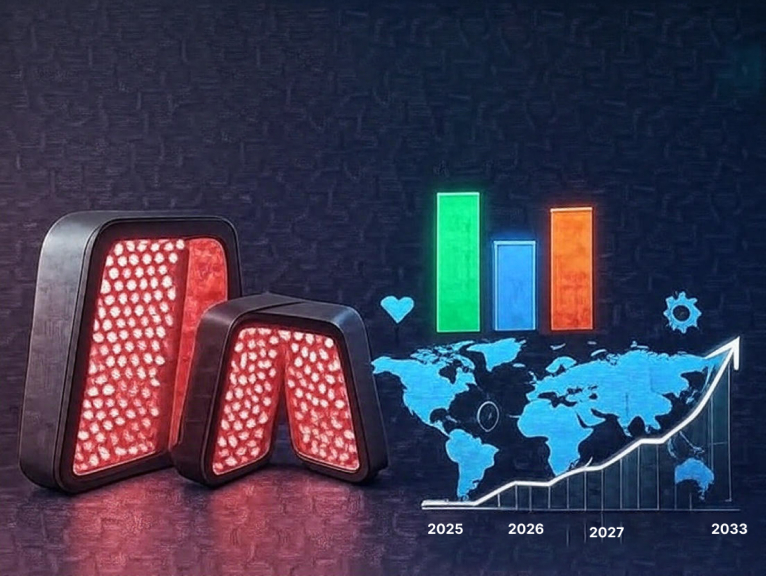
20 Years of Producing the Highest Quality, Most Reliable, and Effective LED mask.
Explore the light therapy market's projected growth from $1.03B in 2025 to $2.68B by 2033. Discover drivers, regional insights, key segments like handheld devices, and opportunities in skin care, sleep, and SAD treatment for 2025 and beyond.

Light therapy, also known as phototherapy or photobiomodulation, has evolved from a niche medical treatment to a mainstream wellness solution, harnessing specific wavelengths of light to stimulate cellular function and address a range of health issues. Originally used for seasonal affective disorder (SAD) and skin conditions like psoriasis, it now extends to acne, wound healing, pain management, and sleep disorders by boosting mitochondrial ATP production and reducing inflammation. The COVID-19 pandemic accelerated adoption, as remote workers sought home-based remedies for mood and vitamin D deficiencies, with small studies indicating improvements in sleep quality and fatigue. As antibiotic resistance and mental health concerns rise, light therapy offers a non-invasive, drug-free alternative. In 2025, the global market is valued at approximately USD 1.03 billion, projected to surge to USD 2.68 billion by 2033 at a 4.8% CAGR, driven by technological advancements and consumer demand. This article provides an in-depth analysis of projections, drivers, trends, segments, regional dynamics, competitive landscape, challenges, and opportunities, offering strategic insights for stakeholders in the wellness, beauty, and medical sectors.
The light therapy market has exhibited strong resilience, expanding from USD 1.0 billion in 2022 to an estimated USD 1.03 billion in 2025, with projections reaching USD 1.28 billion by 2030 at a 4.44% CAGR and up to USD 2.64 billion by 2033 at 4.8%. Earlier data from 2018 valued it at USD 811.8 million, growing at 5.1% to around USD 1.1 billion by 2025, but post-pandemic adjustments reflect accelerated home-use adoption. The phototherapy treatment submarket is forecasted at USD 1.77 billion in 2025, expanding to USD 2.58 billion by 2034, while red light therapy devices alone are projected to hit USD 620 million by 2032 at an 8.8% CAGR. North America dominates with USD 1.35 billion in 2025, driven by high awareness and infrastructure, while Asia-Pacific shows the fastest growth at 5.7% through 2027 due to rising disposable incomes and urbanization. This trajectory is supported by increasing R&D investments and regulatory approvals, positioning light therapy as a key player in the $5.1 trillion global wellness industry.
The market's expansion is multifaceted, with primary drivers including the escalating prevalence of dermatological conditions—affecting over 1 billion people globally—and mental health disorders like SAD, impacting 5-10% of populations in temperate climates. The post-COVID surge in home wellness, with 70% of consumers prioritizing mental health, has boosted demand for portable devices. Technological innovations, such as cost-effective LEDs and app-integrated systems, have lowered barriers, with prices dropping 20-30% since 2020. Rising disposable incomes in emerging markets, coupled with aging populations (e.g., 1.4 billion over 60 by 2030), drive anti-aging applications. Favorable policies, like FDA clearances for over 50 devices in 2024-2025, and reimbursements for SAD treatment in Europe, accelerate adoption. Additionally, the shift from pharmaceuticals amid antibiotic resistance concerns positions light therapy as a sustainable alternative, with clinical trials showing efficacy rates of 60-80% for acne and psoriasis.
Innovation defines the market's trajectory. Smart devices with AI for personalized dosing—adjusting based on skin type or time of day—are emerging, with examples like Philips' connected lamps launched in 2025. Multi-wavelength therapies, combining red, blue, and NIR, target complex conditions like acne rosacea, showing 25% better outcomes in trials. Wearables, such as LED-integrated headbands for SAD, are gaining popularity, with sales up 40% in 2024. Sustainability trends favor energy-efficient, recyclable materials, aligning with consumer preferences (65% prioritize eco-friendly products). Integration with telehealth for remote consultations and subscription models for ongoing device updates are rising, reducing costs by 15-20% for users. In beauty, K-beauty influences drive facial masks, while medical trends include oncology support for radiation side effects.
Segmentation reveals targeted growth areas.
Handheld devices hold 26-35% share, projected to grow at 5.3-8.8% CAGR due to portability and affordability, valued at over $200 million in 2023. Lamps and boxes follow at 27-30%, used for SAD.
Blue light leads at 35-42%, for acne; red at 36%, growing at 4.89-8.8% for anti-aging.
Skin care dominates at 30-40%; sleep/SAD at 35%, with pain management emerging.
Home care at 54-60%, growing at 5.12% from $495M in 2018; clinics at 40%.
North America: USD 1.35B in 2025, to USD 2.68B by 2033 at 4.8%, led by US ($337M in 2023 to $448M by 2030) with high SAD prevalence and innovations. Asia-Pacific: Over $175M in 2018, 5.7% CAGR to 2027, driven by urbanization in China/India. Europe: Steady at 4.6%, with reimbursements; Latin America/MEA growing with awareness.
The market is fragmented, with leaders like Koninklijke Philips, Beurer GmbH, and Lumie holding 30-40% share through R&D. Recent moves: Philips' 2025 smart lamp launch; Beurer's expansion in Asia. Startups focus on wearables, with M&A rising—e.g., acquisitions in red light tech.
High device costs (e.g., $200-$500 for premium units) limit penetration in low-income regions. Limited reimbursements for non-medical uses and varying regulations (e.g., stricter in Europe) delay launches. Awareness gaps, especially in rural areas, and competition from alternatives like supplements hinder growth. Supply chain vulnerabilities for LEDs and potential side effects like eye strain require education.
By 2033, the market is expected to reach USD 2.64B, with opportunities in AI-personalized devices (e.g., adaptive wavelengths) and integrations with smart homes. Expansion into oncology side-effect management and sports recovery, valued at $100M+ by 2030, offers niches. Emerging markets like India, with 5.6% CAGR, present untapped potential. Sustainability initiatives, like recyclable devices, can attract eco-conscious consumers.
Businesses can enter via product development in handheld segments or partnerships for distribution. Invest in R&D for AI features; marketing via e-commerce yields 20-30% margins. Scale with subscriptions for recurring revenue in home care.
The light therapy market's surge offers vast potential—leverage trends for innovation. Explore LedMask.co for updates.
<a name="references"></a>
